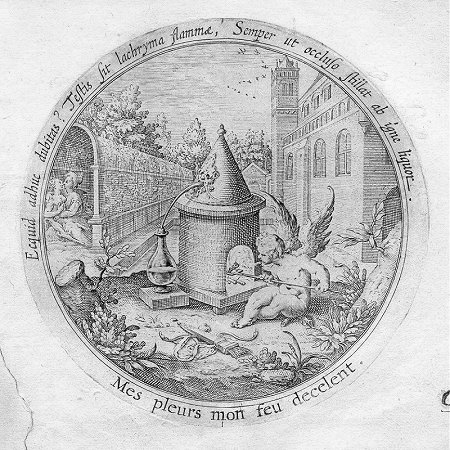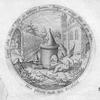Daniël Heinsius, Emblemata amatoria (1607/8)
Table of contents ↑Mes pleurs mon feu decelent [3]

Mijn vyer brand meer end’ meer/ wat sal het eynde wesen?
Het water spruyt uyt vier/ end’ kan my niet ghenesen:
Mijn vyer dat wordt ghestoockt/ mijn vyer dat brand en blaeckt
Soo langhe dat mijn vyer my een fonteyne maeckt.
Van tranen vloey’ ick wech/ wil zy my niet verhooren
Ick moet doch eyndelijck int water gans versmooren.
O wonderbaren brant/ van branden comt my dat.
Ick swemme daer ick gae/ den brant die maeckt my nat.
Het water spruyt uyt vier/ end’ kan my niet ghenesen:
Mijn vyer dat wordt ghestoockt/ mijn vyer dat brand en blaeckt
Soo langhe dat mijn vyer my een fonteyne maeckt.
Van tranen vloey’ ick wech/ wil zy my niet verhooren
Ick moet doch eyndelijck int water gans versmooren.
O wonderbaren brant/ van branden comt my dat.
Ick swemme daer ick gae/ den brant die maeckt my nat.


Translations
 |
Mijn tranen verraden mijn vuur. |
 |
My tears bear witness of my fire. |
 |
Waarom aarzel je nog? Laten mijn tranen getuigen zijn van mijn liefdesvuur, zoals er altijd condens vrijkomt bij vuur dat is opgesloten. |
 |
What do you hesitate? Let my tears reveal that I am burning, just as water always trickles from a banked fire. |
Sources and parallels
- Same emblem in 1601 edition: Mes pleurs mon feu decelent [3]
 (in: Daniël Heinsius, Quaeris quid sit Amor (c. 1601)
(in: Daniël Heinsius, Quaeris quid sit Amor (c. 1601) )
[Compare
)
[Compare ]
]
- Source for the motto, pictura and entire emblem: Scève, Délie
 , embl. 23
, embl. 23
- Probable source for the pictura and perhaps the entire emblem: La Perriëre, Theatre
 , embl. 79
, embl. 79
- A parallel (and probably adaptation) for the latin subscriptio, the
pictura and the entire emblem: Sunt lacrymæ testes [95]
 (in: Otto Vaenius, Amorum emblemata (1608)
(in: Otto Vaenius, Amorum emblemata (1608) )
[Compare
)
[Compare ]
]
- A parallel for the pictura: Covarrubias, Emblemas Morales
 , bk/embl. III/63
, bk/embl. III/63 - A parallel (and probably adaptation) for the pictura (background): Fit spolians spolium. [12]
 (in: Jacob Cats, Sinne- en minnebeelden (1627)
(in: Jacob Cats, Sinne- en minnebeelden (1627) )
[Compare
)
[Compare ]
]
-
A parallel in the 1616 edition: motto and subscriptio the same; pictura is mirrored and some details disappeared
(the lovers in the gallery): Mes pleurs mōn feu decelēt. [27]
 (in: Daniël Heinsius, Ambacht van Cupido, from: Nederduytsche poemata (1616)
(in: Daniël Heinsius, Ambacht van Cupido, from: Nederduytsche poemata (1616) )
[Compare
)
[Compare ]
]
-
Partial parallel for the pictura: some elements in the background are the same (gallery, castle): Animæ felicitas [96]
 (in: Jan Suderman, De godlievende ziel (1724)
(in: Jan Suderman, De godlievende ziel (1724) )
[Compare
)
[Compare ]
]
-
Lovers in a garden house: Den Hemel van des minnars sin is sijn in t'groen by sijn goddin [1]
 (in: anonymous, Cupido’s lusthof (1613)
(in: anonymous, Cupido’s lusthof (1613) )
[Compare
)
[Compare ]
]
-
A partial parallel for the pictura: some elements in the background are the same (castle and gallery (without lovers
now), both mirrored). Fit spolians spolium. [11]
 (in: Jacob Cats, Proteus (1618)
(in: Jacob Cats, Proteus (1618) )
[Compare
)
[Compare ]
]
-
A parallel (and probably adaptation) for the pictura (background): Amoris felicitas [51]
 (in: Otto Vaenius, Amoris divini emblemata (1615)
(in: Otto Vaenius, Amoris divini emblemata (1615) )
[Compare
)
[Compare ]
]
-
Porteman 1975, p. 212. Pictura substantially altered in:Antidotum Amoris [42]
 (in: Ludovicus van Leuven, Amoris divini et humani antipathia (1629)
(in: Ludovicus van Leuven, Amoris divini et humani antipathia (1629) )
[Compare
)
[Compare ]
]
-
Porteman 1975, p. 212. Fleeing is useless.Assiduitas Amoris [27]
 (in: Ludovicus van Leuven, Amoris divini et humani antipathia (1629)
(in: Ludovicus van Leuven, Amoris divini et humani antipathia (1629) )
[Compare
)
[Compare ]
]
-
Same pictura, altered, different motto and Latin subscriptio:Sunt Lachrymæ Testes. [44]
 (in: anonymous, Emblemata amatoria (1690)
(in: anonymous, Emblemata amatoria (1690) )
[Compare
)
[Compare ]
]
References, across this site, to this page:
- Fit spolians spolium. [11]
 (in: Jacob Cats, Proteus (1618)
(in: Jacob Cats, Proteus (1618) )
)
- Fit spolians spolium. [12]
 (in: Jacob Cats, Sinne- en minnebeelden (1627)
(in: Jacob Cats, Sinne- en minnebeelden (1627) )
)
- Den Hemel van des minnars sin is sijn in t'groen by sijn goddin [1]
 (in: anonymous, Cupido’s lusthof (1613)
(in: anonymous, Cupido’s lusthof (1613) )
)
- Sunt Lachrymæ Testes. [44]
 (in: anonymous, Emblemata amatoria (1690)
(in: anonymous, Emblemata amatoria (1690) )
)
- Mes pleurs mon feu decelent [3]
 (in: Daniël Heinsius, Quaeris quid sit Amor (c. 1601)
(in: Daniël Heinsius, Quaeris quid sit Amor (c. 1601) )
)
- Mes pleurs mon feu decelent. [27]
 (in: Daniël Heinsius, Ambacht van Cupido (1613)
(in: Daniël Heinsius, Ambacht van Cupido (1613) )
)
- Mes pleurs mōn feu decelēt. [27]
 (in: Daniël Heinsius, Ambacht van Cupido, from: Nederduytsche poemata (1616)
(in: Daniël Heinsius, Ambacht van Cupido, from: Nederduytsche poemata (1616) )
)
- Animæ felicitas [96]
 (in: Jan Suderman, De godlievende ziel (1724)
(in: Jan Suderman, De godlievende ziel (1724) )
)
- Sunt lacrymæ testes [95]
 (in: Otto Vaenius, Amorum emblemata (1608)
(in: Otto Vaenius, Amorum emblemata (1608) )
)
- Amoris felicitas [51]
 (in: Otto Vaenius, Amoris divini emblemata (1615)
(in: Otto Vaenius, Amoris divini emblemata (1615) )
)
